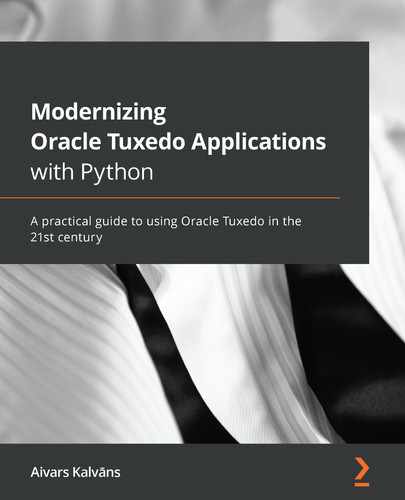Learn Tuxedo by developing solutions in Python for real-world problems Despite being developed in the 1980s, Oracle Tuxedo still runs a significant part of critical infrastructure and is not going away any time soon. Modernizing Oracle Tuxedo Applications with Python will help you get to grips with the most important Tuxedo concepts by writing Python code. The book starts with an introduction to Oracle Tuxedo and guides you in installing its latest version and Python bindings for Tuxedo on Linux. You'll then learn how to build your first server and client, configure Tuxedo, and start running an application. As you advance, you'll understand load balancing and work with the BBL server, which is at the heart of a Tuxedo application. This Tuxedo book will also cover Boolean expressions and different ways to export Tuxedo buffers for storage and transmission, before showing you how to implement servers and clients and use the management information base to change the configuration dynamically. Once you've learned how to configure Tuxedo for transactions and control them in application code, you'll discover how to use the store-and-forward functionality to reach destinations and use an Oracle database from a Tuxedo application. By the end of this Oracle Tuxedo book, you'll be able to perform common Tuxedo programming tasks with Python and integrate Tuxedo applications with other parts of modern infrastructure. This book is for developers who are new to Tuxedo and are looking to develop a new modern front-end or integrate Tuxedo in their applications. The book will also help experienced Tuxedo, C or COBOL developers to improve their productivity and QA engineers to automate Tuxedo application tests. Beginner-level knowledge of Python and Linux shell is required before getting started with this book.Key Features
Book Description
What you will learn
Who this book is for
Table of Contents
- Modernizing Oracle Tuxedo Applications with Python
- Contributors
- About the author
- About the reviewer
- Preface
- Section 1: The Basics
- Chapter 1: Introduction and Installing Tuxedo
- Chapter 2: Building Your First Tuxedo Application
- Chapter 3: Tuxedo in Detail
- Chapter 4: Understanding Typed Buffers
- Technical requirements
- Introducing typed buffers
- Using STRING typed buffers
- Using CARRAY typed buffers
- Using FML32 typed buffers
- Using FML32 in Python
- Working with field identifiers
- Defining fields
- Displaying FML32 typed buffers
- Writing FML32 expressions
- Importing and exporting typed buffers
- Summary
- Questions
- Further reading
- Section 2: The Good Bits
- Chapter 5: Developing Servers and Clients
- Chapter 6: Administering the Application Using MIBs
- Chapter 7: Distributed Transactions
- Chapter 8: Using Tuxedo Message Queue
- Chapter 9: Working with Oracle Database
- Section 3: Integrations
- Chapter 10: Accessing the Tuxedo Application
- Chapter 11: Consuming External Services in Tuxedo
- Chapter 12: Modernizing the Tuxedo Applications
- Assessments
- Other Books You May Enjoy
